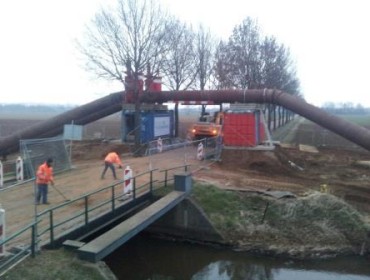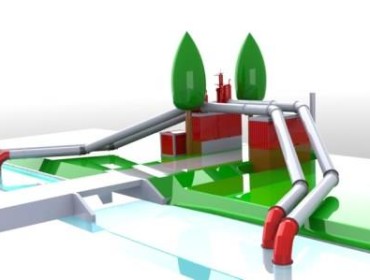Simple is beautiful
Why make something difficult when it could just as well be easy? This is a kind of motto for Jeroen van Heck, the man who loves complex issues, but always goes for the simple solution, because (another motto) “simple is beautiful”. The beauty of this is that the customer invariably benefits the most from the simplest solutions. This probably explains why Van Heck is such a big fan of the time-honoured siphon technique.
Nature invented it, and Newton described it in the laws of gravity. Water naturally runs from high points to lower points. As a pump expert, you might be inclined to say to the customer: We’re going to pump it. On the other hand, if you’re motivated to always find the best, the simplest, the cheapest and the most environmentally friendly solution, then siphoning is almost invariably the best solution. That doesn’t necessarily mean Van Heck is it’s own worst competitor. On the contrary: we use pumps in projects where they’re really needed. Van Heck is in fact highly competitive, because its customers invariably opt for siphoning techniques when they find out about the benefits of the concept.
Siphoning is exactly the same process used to drain petrol from a scooter’s fuel tank: you give a gentle suck on the hosepipe, you lower the outlet, and the fuel automatically flows out of the tank. Of course you’d need a few other smart techniques and a pretty impressive setup to run a stream up and over a road. Which is exactly what Van Heck had to deal with recently when asked to run the Lage Raam creek across a road in the province of Brabant. The idea was to run the little river across the road through a 70-metre pipeline with a one-metre diameter while the contractor replaced the existing weir. A pipeline was set up 4.5 metres above the road surface and six metres above the normal water level to allow the traffic passed under uninterrupted.
A thousand times more economical
A series of vacuum pumps are used to suck air out of a pipe. Van Heck’s job is to make sure that the pipe’s inlet and outflow points remain underwater and that a pump will kick the moment unwanted air does enter the pipeline. Jeroen van Heck: “The diesel pumps we use normally displace water at 6,000 m³/hour and use about 100 litres of fuel per hour. Siphoning costs a few litres of fuel a day! That’s a big saving! And it obviously also helps to save the environment.”
Jeroen explains: “It’s a service. We like to think with our customers and we always end up using the most innovative, the most environmentally friendly and also the cheapest technology. And our customers are usually so enthusiastic about our smart proposals that they only think of looking at the price tab later. The fact that we operate so well in the international market for so long means that we can come up with highly competitive prices. At the end of the day, everyone comes away a winner.”


